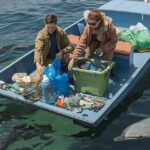Table of Contents
Eco-friendly practices for Houseboating have evolved from a niche lifestyle to a mainstream adventure, and with this growth comes an increasing responsibility to protect our precious waterways. Green boating is no longer just a trend—it’s a necessity.
As more people discover the joy of living and traveling on water, sustainable boating practices have become crucial in preserving the delicate marine ecosystems we cherish.
This comprehensive guide explores eco-friendly practices for houseboating, offering practical insights into creating a sustainable floating home that minimizes environmental impact while maximizing enjoyment.
Let dive in.
Understanding Eco-Friendly Practices for Houseboating
What is Eco-Friendly Houseboating?
Eco-friendly houseboating represents a holistic approach to water-based living that prioritizes environmental protection. It goes beyond simply enjoying the water—it’s about becoming a responsible steward of marine environments.
Key Principles of Sustainable Boating
- Minimizing carbon footprint
- Protecting marine life
- Using renewable energy sources
- Implementing efficient waste management
- Choosing sustainable materials
Sustainable Building Materials
Choosing Sustainable Materials for Houseboat Construction
Selecting the right materials is the first step in creating an environmentally responsible houseboat. Sustainable materials play a critical role in reducing the ecological footprint of your floating home.

Recycled and Reclaimed Materials
| Material | Benefits | Applications |
|---|---|---|
| Reclaimed Wood | Reduces deforestation | Decking, interior paneling |
| Recycled Plastic Composites | Diverts waste from landfills | Exterior siding, structural components |
| Recycled Metal | Lower carbon emissions | Framing, hardware |
Natural and Renewable Materials
Eco-friendly materials like bamboo and cork offer incredible advantages:
- Rapidly renewable resources
- Lightweight and durable
- Low environmental impact
- Excellent insulation properties
Energy Efficiency on Houseboats
Implementing Energy-Efficient Solutions
Solar Power Systems
Solar panels have revolutionized green boating by providing clean, renewable energy. Modern solar energy solutions can power entire houseboats, dramatically reducing reliance on fossil fuels.
Wind and Water Turbines
Another fantastic renewable energy source, wind and water turbines can supplement solar power, creating a comprehensive clean energy approach.
Energy-Efficient Appliances
Choosing zero emissions appliances helps reduce overall energy consumption and supports a sustainable lifestyle.
Waste Management and Water Conservation
Effective Waste Management Strategies
Composting Toilets
Composting toilets represent a significant advancement in waste management, transforming human waste into valuable compost while conserving water.
Water Conservation Techniques
Efficient water usage is crucial in sustainable boating. Consider these strategies:
- Install low-flow fixtures
- Collect rainwater
- Use greywater recycling systems
- Implement water-saving habits
Renewable Energy Options
Exploring Renewable Energy Sources
| Energy Source | Advantages | Challenges |
|---|---|---|
| Solar Energy | Clean, Quiet | Weather Dependent |
| Biofuels | Renewable, Lower Emissions | Limited Availability |
| Hybrid/Electric Engines | Reduced Emissions | Initial Cost |
Eco-Friendly Boating Practices
Green Boating Tips
Low-impact boating requires mindful practices:
- Use biodegradable cleaning products
- Avoid disturbing wildlife
- Properly dispose of waste
- Minimize engine use in sensitive areas
Protecting Marine Life
Marine life conservation demands respect and active protection. Always maintain safe distances from marine animals and avoid creating unnecessary disturbances.
Benefits of Eco-Friendly Houseboating

Environmental and Personal Advantages
Sustainable tourism through eco-friendly houseboating offers numerous benefits:
- Reduced greenhouse gases
- Preservation of marine ecosystems
- Lower long-term operational costs
- Enhanced personal connection with nature
Future Trends in Sustainable Houseboating
Green marine technology continues to evolve, promising even more innovative eco-friendly solutions for water-based living.
FAQs
How to Make a Boat Eco-Friendly?
Transforming your boat into an environmentally responsible vessel starts with a holistic approach to sustainability. Begin by evaluating your current boat’s energy consumption, materials, and waste management systems.
Consider retrofitting with solar panels, installing energy-efficient appliances, and replacing traditional engines with hybrid or electric alternatives that significantly reduce carbon emissions.
The journey to an eco-friendly boat goes beyond technology. It’s about developing a mindset of conservation and mindful practices.
This means using biodegradable cleaning products, implementing a robust recycling system, collecting and properly disposing of waste, and being conscious of your impact on marine ecosystems.
Every small change contributes to a larger environmental preservation effort.
What Are Eco-Friendly Habits to Save the Environment?
Saving our environment isn’t about grand gestures, but consistent, intentional actions that become part of our daily routine.
Start by reducing single-use plastics, choosing reusable alternatives, and being mindful of your consumption patterns.
Implement a comprehensive recycling system in your home and boat, separating waste, composting organic materials, and ensuring that recyclable items find their way to appropriate processing facilities.
Energy conservation is another critical aspect of eco-friendly living. This means being intentional about your energy use – turning off lights when not in use, using energy-efficient appliances, maximizing natural lighting, and considering renewable energy sources like solar and wind.
Your personal choices can create a ripple effect, inspiring others to adopt more sustainable practices and collectively work towards environmental preservation.
How Can Boats Be More Sustainable?
Sustainability in boating requires a multi-faceted approach that addresses energy, materials, and operational practices. Invest in renewable energy systems like solar panels and wind turbines, which can significantly reduce reliance on fossil fuels.
Choose materials that are recycled, reclaimed, or sustainably sourced, and prioritize lightweight, durable components that minimize your boat’s overall environmental footprint.
Operational sustainability extends beyond equipment. Practice responsible navigation by avoiding sensitive marine habitats, maintaining your boat to prevent oil and fuel leaks, and using biodegradable products.
Implement water conservation techniques, such as collecting rainwater, using efficient fixtures, and treating and reusing greywater. These practices not only protect marine ecosystems but also create a more responsible and conscious boating experience.
How Can I Design an Eco-Friendly Home?
Designing an eco-friendly home starts with thoughtful material selection and energy-efficient design principles. Choose sustainable, locally sourced materials with low environmental impact, such as reclaimed wood, recycled metal, and rapidly renewable resources like bamboo.
Prioritize excellent insulation, incorporate passive solar design, and consider integrating green technologies like solar panels, rainwater harvesting systems, and energy-efficient appliances.
Beyond physical design, creating an eco-friendly home involves developing sustainable lifestyle habits. This means implementing comprehensive recycling and composting systems, using natural and non-toxic cleaning products, minimizing water and energy consumption, and creating spaces that connect with nature.
Your home becomes not just a living space, but a statement of environmental responsibility and conscious living.
How Can Ships Be More Environmentally Friendly?
Environmental friendliness in maritime transportation requires a comprehensive approach to reducing emissions, waste, and ecological impact.
Modern ships can integrate advanced technologies like liquefied natural gas (LNG) propulsion, wind-assist technologies, and sophisticated waste management systems.
Implementing hull designs that improve fuel efficiency, using alternative fuels, and investing in carbon capture technologies are critical steps toward sustainable maritime operations.
Crew training and operational practices play an equally important role. This involves optimizing routes to reduce fuel consumption, implementing strict waste segregation protocols, using biodegradable cleaning agents, and developing a culture of environmental consciousness.
By combining technological innovation with behavioral changes, ships can significantly reduce their environmental footprint and contribute to marine ecosystem preservation.
What Is the Most Environmentally Friendly Boat?
The most environmentally friendly boat is one that integrates multiple sustainable technologies and practices. Electric and hybrid boats, particularly those powered by renewable energy sources like solar and wind, represent the pinnacle of eco-friendly marine transportation.
These vessels minimize carbon emissions, reduce noise pollution, and demonstrate that high-performance boating can coexist with environmental stewardship.
However, environmental friendliness extends beyond propulsion technology. The most sustainable boat will also feature recycled or sustainable construction materials, comprehensive waste management systems, energy-efficient appliances, and be operated with a commitment to marine conservation.
It’s not just about the boat’s design, but the holistic approach to reducing environmental impact throughout its lifecycle.
What Are Environmentally Friendly Practices?
Environmentally friendly practices encompass a wide range of actions that minimize negative impacts on our planet.
These include reducing waste, conserving energy and water, choosing sustainable transportation options, supporting local and sustainable food systems, and making conscious consumer choices that prioritize environmental health. It’s about understanding the interconnectedness of our actions and their potential ecological consequences.
Implementing these practices requires a shift in mindset from convenience to consciousness. This means being willing to make small sacrifices for long-term environmental benefits, such as using public transportation, supporting businesses with strong environmental credentials, reducing meat consumption, and actively participating in local conservation efforts. Every individual action contributes to a larger movement of environmental stewardship.
What Are the 5 Habits to Protect Environment?
The five fundamental habits to protect the environment revolve around conscious consumption, waste reduction, energy efficiency, water conservation, and active participation in environmental initiatives.
First, reduce single-use plastics and choose reusable alternatives. Second, implement a robust recycling and composting system. Third, minimize energy consumption by using efficient appliances and renewable energy sources.
Fourth, conserve water through mindful usage and innovative technologies like rainwater harvesting and greywater recycling.
Finally, actively engage in environmental education and community initiatives that promote sustainability. These habits are not just individual actions but collective steps towards creating a more sustainable and resilient planet for future generations.
Conclusion
Embracing sustainable boating is more than a choice—it’s a commitment to protecting our planet’s most precious resource: water. By adopting these eco-friendly practices, you’re not just creating a home; you’re becoming a guardian of our marine environments.
Let’s sail towards a greener, more sustainable future—one houseboat at a time!





Pingback: Essential Houseboat Maintenance Tasks Every Owner Needs oceangrandeur.com
Pingback: Green Products for Houseboat Travel oceangrandeur.com